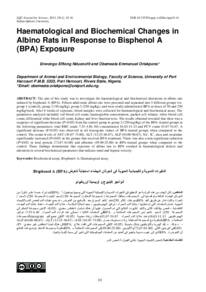وثيقة
Haematological and biochemical changes in albino rats in response to bisphenol a (BPA) exposure.
المعرف
https://doi.org/10.53539/squjs.vol28iss1pp10-16
المصدر
Sultan Qaboos University Journal for Scientific. v. 28, no. 1, p. 10-16.
المساهمون
عناوين أخرى
التغيرات الدموية والكيميائية الحيوية في الجرذان البيضاء استجابة لتعرض Bisphenol A (BPA).
الدولة
Oman
مكان النشر
Muscat.
الناشر
College of Science, Sultan Qaboos University.
ميلادي
2023-01-01
اللغة
الأنجليزية
الملخص الإنجليزي
The aim of this study was to investigate the haematological and biochemical alterations in albino rats induced by bisphenol A (BPA). Fifteen adult male albino rats were procured and separated into 3 different groups viz: group 1 (control), group 2 (50 mg/kg), group 3 (250 mg/kg); and were orally administered BPA at doses of 50 and 250 mg/kg/week. After 6 weeks of exposure, blood samples were collected for haematological and biochemical assay. The parameters analyzed included: red blood cell count, haemoglobin concentration, packed cell volume, white blood cell count, differential white blood cell count, kidney and liver function tests. The results obtained revealed that there was a sequence of significant decrease (P0.05) from the control group to group 3 (250 mg//kg) of the BPA-treated groups in the following parameters; total RBC count 7.33-4.40, Hb concentration 16.63-11.13 and PCV count 43.67-34.67. A significant increase (P0.05) was observed in all leucogram values of BPA-treated groups when compared to the control. The serum levels of AST (44.67-71.00), ALT (13.33-46.67), ALP (64.00-86.67), Na+, K+, urea and creatinine significantly increased (P0.05) in the groups that received BPA-treatment. There was also a non-significant reduction (P>0.05) in total protein (72.67-61.00) and albumin (49.00-25.00) in BPA-treated groups when compared to the control. These findings demonstrate that exposure of albino rats to BPA resulted in haematological defects and alteration in several biochemical parameters that indicate renal and hepatic toxicity.
ISSN
2414-536X
الملخص العربي
كان الهدف من هذه الدراسة هو دراسة التغيرات الدموية والكيميائية الحيوية في الجرذان البيضاء المحدثة بواسطة البيسفينول أ (BPA). تم شراء خمسة عشر فأرًا أبيضًا من الذكور البالغين وفصلهم إلى 3 مجموعات مختلفة: المجموعة 1 (التحكم)، المجموعة 2 (50 مجم / كجم)، المجموعة 3 (250 مجم / كجم)؛ وتم إعطاؤهم مادة BPA عن طريق الفم بجرعات 50 و 250 ملغم / كغم / أسبوع. بعد 6 أسابيع من التعرض، تم جمع عينات الدم لفحص الدم والكيمياء الحيوية. وشملت المعلمات التي تم تحليلها: عدد خلايا الدم الحمراء، وتركيز الهيموجلوبين، وحجم الخلايا المعبأة، وعدد خلايا الدم البيضاء، وعدد خلايا الدم البيضاء التفاضلية، واختبارات وظائف الكلى والكبد. كشفت النتائج التي تم الحصول عليها أن هناك سلسلة من الانخفاض الكبير (P <0.05) من المجموعة الضابطة إلى المجموعة 3 (250 مجم // كجم) من المجموعات المعالجة بـ BPA في المعلمات التالية؛ إجمالي عدد كرات الدم الحمراء 7.33-4.40، تركيز Hb 16.63-11.13 وعدد PCV 43.67-34.67. وقد لوحظت زيادة معنوية (P<0.05) في جميع قيم مخطط الدم البيضاء للمجموعات المعالجة بمادة BPA بالمقارنة مع مجموعة السيطرة. ارتفعت مستويات AST (44.67-71.00) وALT (13.33-46.67) وALP (64.00-86.67) وNa+ وK+ واليوريا والكرياتينين بشكل ملحوظ (P<0.05) في المجموعات التي تلقت علاج BPA. كان هناك أيضًا انخفاض غير ملحوظ (P > 0.05) في إجمالي البروتين (72.67-61.00) والألبومين (49.00-25.00) في المجموعات المعالجة بـ BPA بالمقارنة مع مجموعة التحكم. توضح هذه النتائج أن تعرض الجرذان البيضاء لمادة BPA أدى إلى عيوب دموية وتغير في العديد من العوامل البيوكيميائية التي تشير إلى سمية الكلى والكبد.
قالب العنصر
مقالات الدوريات

